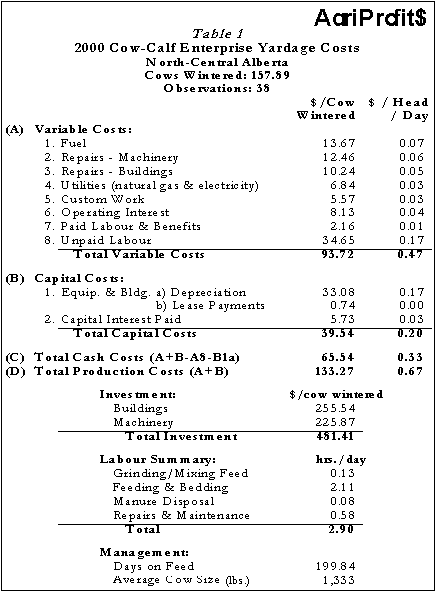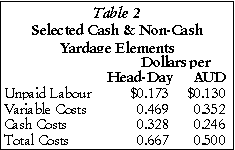| | Securing feed to cover pasture shortfalls may be your first priority at this time. However, when you’re building your cash flow projections, it’s important to recognize that there are other costs above feeds involved with maintaining cattle in drylot. These costs are commonly referred to as "yardage".
Table 1 details some of the cash and non-cash costs related to keeping cattle in drylot … over and above the cost of feed. Estimates were drawn from our AgriProfit$ research program data for a recent North Central Alberta project.

The costing profile focuses directly on the costs related to maintaining cattle in drylot. As such, it excludes calving labour and costs associated with raising forages for feed or grazing.
Costing and feeding capacity can vary substantially with animal size. Accounting for “animal units”, as opposed to “head” is important. An animal unit is roughly equivalent to a 1,000 lb cow (with or without a calf at-side). A straight linear conversion based on the ratio of your herd’s average cow weight to this standard Animal Unit weight will be accurate enough for most instances. This conversion can also be used for feeder cattle.
In Table 2, the more significant cash and non-cash elements are presented on a per head-day and a per Animal Unit Day (AUD) basis. Your yardage costs may vary somewhat from the AgriProfit$ benchmarks (our experience in working with producers has shown that these differences can be substantial). If you don’t have yardage estimates for your own operation, then the “element” totals should provide you with a reasonable basis to do your budgets.

As you progress through your cash flow and profitability budgets to assess your alternatives in managing feed or grazing shortages, different aspects of yardage will come into play.
In cash flow budgets, it’s necessary to recognize the additional cash operating costs related to drylot feeding. The benchmarks indicate an additional $0.24-to-$0.25/AUD, after factoring out unpaid labour and depreciation. For every 100 days additional feeding time, this amounts to another $25/AU ($33 per 1,300 lb cow) you’ll need to allow for in your budget.
Profitability analysis demands that all cash and non-cash production costs be retired over the intermediate to longer term. Putting this into perspective, the additional $0.50/AUD invested in dry-lotting cows now will have to be covered by future profits from the herd.
At a time when decision timelines may be tight and cash operating margins slim, it’s important to make sure you’ve got all of your bases covered.
Although most of your efforts may be focused on laying in feeds for now or in the near future, when you’re doing your budgets, don’t forget that yardage can have a significant effect on your ultimate decision.
Dale A. Kaliel
Sr. Economist: Production Economics
Economics & Competitiveness Division
For more information contact:
Alberta Ag-Info Centre at 310-FARM (3276) |
|